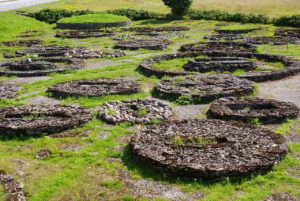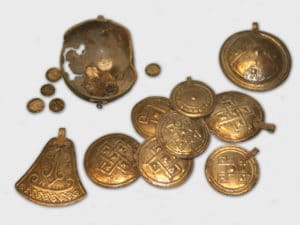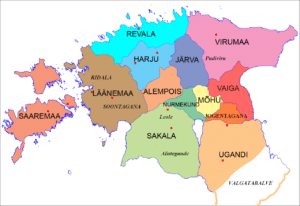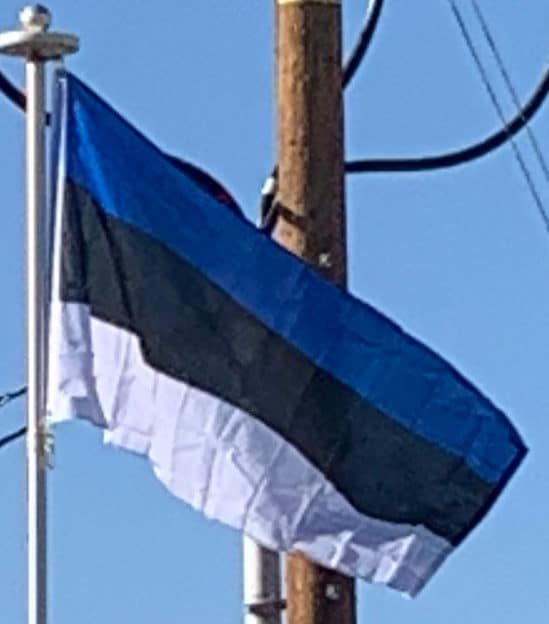The earliest human habitation during the Mesolithic period is connected to the Kunda culture, named after the town of Kunda in northern Estonia. At that time the country was covered with forests, and people lived in semi-nomadic communities near bodies of water. Subsistence activities consisted of hunting, gathering and fishing. Around 4900 BC ceramics appear of the neolithic period, known as Narva culture. Starting from around 3200 BC the Corded Ware culture appeared; this included new activities like primitive agriculture and animal husbandry.

The Bronze Age started around 1800 BC, and saw the establishment of the first hill fort settlements. A transition from hunting-fishing-gathering subsistence to single-farm-based settlement started around 1000 BC, and was complete by the beginning of the Iron Age around 500 BC. The large amount of bronze objects indicate the existence of active communication with Scandinavian and Germanic tribes.
The middle Iron Age produced threats appearing from different directions. Several Scandinavian sagas referred to major confrontations with Estonians, notably when “Estonian Vikings” defeated and killed the Swedish king Ingvar. Similar threats appeared in the east, where Russian principalities were expanding westward. In 1030 Yaroslav the Wise defeated Estonians and established a fort in modern-day Tartu; this foothold lasted until an Estonian tribe, the Sosols, destroyed it in 1061, followed by their raid on Pskov. Around the 11th century, the Scandinavian Viking era around the Baltic Sea was succeeded by the Baltic Viking era, with seaborne raids by Curonians and by Estonians from the island of Saaremaa, known as Oeselians. In 1187 Estonians (Oeselians), Curonians or/and Karelians sacked Sigtuna, which was a major city of Sweden at the time.

Estonia could be divided into two main cultural areas, the coastal areas of Northern and Western Estonia had close overseas contacts with Scandinavia and Finland, while inland Southern Estonia had more contacts with Balts and Pskov. The landscape of Ancient Estonia featured numerous hillforts. Prehistoric or medieval harbor sites have been found on the coast of Saaremaa. Estonia also has a number of graves from the Viking Age, both individual and collective, with weapons and jewelry including types found commonly throughout Northern Europe and Scandinavia.
In the early centuries AD, political and administrative subdivisions began to emerge in Estonia. Two larger subdivisions appeared: the parish (Estonian: kihelkond) and the county (Estonian: maakond), which consisted of multiple parishes. A parish was led by elders and centred around a hill fort; in some rare cases a parish had multiple forts. By the 13th century Estonia consisted of eight major counties: Harjumaa, Järvamaa, Läänemaa, Revala, Saaremaa, Sakala, Ugandi, and Virumaa; and six minor, single-parish counties: Alempois, Jogentagana, Mõhu, Nurmekund, Soopoolitse, and Vaiga. Counties were independent entities and engaged only in a loose co-operation against foreign threats.

There is little known of early Estonian pagan religious practices. The Chronicle of Henry of Livonia mentions Tharapita as the superior god of the Oeselians. Spiritual practices were guided by shamans, with sacred groves, especially oak groves, serving as places of worship.
Middle Ages:
In 1199 Pope Innocent III declared a crusade to “defend the Christians of Livonia”. Fighting reached Estonia in 1206, when Danish king Valdemar II unsuccessfully invaded Saaremaa. The German Livonian Brothers of the Sword, who had previously subjugated Livonians, Latgalians, and Selonians, started campaigning against the Estonians in 1208, and over next few years both sides made numerous raids and counter-raids. A major leader of the Estonian resistance was Lembitu, an elder of Sakala County, but in 1217 the Estonians suffered a significant defeat in the Battle of St. Matthew’s Day, where Lembitu was killed. In 1219, Valdemar II landed at Lindanise, defeated the Estonians in battle, and started conquering Northern Estonia. The next year, Sweden invaded Western Estonia, but were repelled by the Oeselians. In 1223, a major revolt ejected the Germans and Danes from the whole of Estonia, except Reval, but the crusaders soon resumed their offensive, and in 1227, Saaremaa was the last county to surrender.
